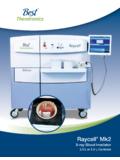Transcription of Cobalt-60: An Old Modality, A Renewed Challenge
1 1 Cobalt-60: An Old modality , A Renewed Challenge Jake Van Dyk and Jerry J. Battista Physics Department London Regional Cancer Centre London, Ontario, Canada KEY WORDS: radiation therapy, cobalt-60, megavoltage x-rays, cost/benefit Correspondence to: Jake Van Dyk, Head, Clinical Physics, London Regional Cancer Centre, 790 Commissioners Road East, London, Ontario, N6A 4L6 Canada. 2 Cobalt-60: An Old modality , A Renewed Challenge Jake Van Dyk and Jerry J. Battista Physics Department London Regional Cancer Centre London, Ontario, Canada "Inconsistencies of opinion, arising from changes of circumstances, are often justifiable." Daniel Webster, 1846 1. INTRODUCTION The discovery of x-rays and radioactivity 100 years ago has led to revolutionary advances in diagnosis and therapy. However, it was not until the middle of the twentieth century that megavoltage photon energies became available through the use of betatrons, cobalt-60 gamma rays and linear accelerators (linacs).
2 The increased photon penetration and skin sparing provided radiation oncologists with new opportunities for optimizing patient treatments. In recent years, several reports have considered various issues which define the "optimum" photon energy for the treatment of malignant disease10,26,41,44. In many of these articles10,26, cobalt-60 is mentioned although it is generally not recommended for radiation therapy departments in the western world. Indeed, many now consider cobalt-60 as an old modality that is only useful for palliative treatments in a large department or for developing countries36,58 with limited technical resources. The paper by Glasgow et published in this issue of Current Oncology reviews the use and dosimetry of a new, extended distance cobalt-60 therapy machine. The authors not only provide detailed physical considerations of this new unit but they also provide a brief comparison of the Cobalt-60: An Old modality , A Renewed Challenge Van Dyk and Battista 3 clinical use of cobalt-60 versus x-rays produced by accelerators.
3 In this commentary, we extend this discussion further. We briefly review the arguments that have been presented both for and against the use of cobalt-60 as well as add some up-to-date insights and perspectives. Undoubtedly, we will not resolve this debate for all clinical situations. However, we hope that by putting "all the cards on the table", the cobalt-60 option will be viewed from a fairer perspective than we have seen in recent years of rapidly advancing accelerator technology. Furthermore, we also make some recommendations for the designers of cobalt-60 technology so that modernized units can be made more attractive for today's radiation therapy facility. 2. LINEAR ACCELERATORS VERSUS COBALT-60: ISSUES FOR COMPARISON Table 1 summarizes issues for comparison for the use of cobalt-60 versus linear accelerators. These issues are not listed in any order of priority although they are broadly categorized according to radiation beam characteristics, machine characteristics, technical support, safety considerations and, finally, cost considerations.
4 Different levels of importance can be assigned to each of these factors according to the local practice of radiation oncology in a cancer centre. Radiation Beam Characteristics Beam edge sharpness (penumbra) (a) Issues for Consideration One of the strongest arguments against cobalt-60 has been the unsharpness of the beam edge or its large penumbra. This is generally manifested by the distance between the 80% to 20% or the 90 to 10% doses at the edge of the beam. Sample data have been published by various authors16,26,41,46. It is important to note that there are sizeable differences between penumbras as published in the literature. These are strongly dependent on both the depth of measurement in water as well as Cobalt-60: An Old modality , A Renewed Challenge Van Dyk and Battista 4 dosimeter type and size. It is clear that for cobalt-60, the penumbra widths increase with source diameter ( to cm), the distance between the source and the bottom of the field definer, and the distance between the field definer and the patient.
5 The x-ray beams from linacs, on the other hand, offer penumbras which are only mildly dependent on geometry due to the small source focal spots ( to cm)38. However, with increasing x-ray energies, the beam edge is blurred by more energetic electrons scattered in tissue over a greater lateral range. The effective penumbra achieved in the patient is thus significantly enlarged compared with a pure geometric penumbra, and it cannot be reduced by machine design. There are at least four other major considerations that should be incorporated in the penumbra criterion for comparison although little quantitative data exist for these considerations. The first has to do with the radiation oncologist's ability to define target volumes accurately or consistently. The need for very precisely defined field edges is based on the assumption that target volumes and normal tissues can be defined with a high degree of accuracy.
6 For some normal tissues and with appropriate imaging data, this assumption can be valid. However, for the accuracy of definition of planning target volumes, very little data exist. A recent study by Leunens et , comparing the variability of 12 physicians defining target volumes of 5 different patients with brain tumours, indicated that the estimated tumour and target sizes varied by factors of and , respectively. Maximum variations were of the order of to cm in the cranio-caudad direction and cm in the fronto-occipital direction. The second consideration has to do with patient motion. Our desire for a tight penumbra is reasonable only if a narrow treatment penumbra can be maintained in clinical practice. However, in reality, patients undergo 20 to 30 fractions for radical therapy and usually 5 to 10 fractions for Cobalt-60: An Old modality , A Renewed Challenge Van Dyk and Battista 5 palliative therapy.
7 As a result, the sharpness of the dose delivered to the patient is strongly dependent on the reproducibility of the patient setup relative to the beam18,25,57. With the recent developments in portal imaging, it is now well recognized that setup reproducibility is typically of the order of cm for head and neck patients (up to cm in Michalski et ) while it is about cm for pelvic and thoracic treatments (up to cm and cm, respectively in the data of Michalski et ). The impact of this will be to blur the edge of the beam with respect to tissue elements near the beam edge. The net result is that even a "perfect" penumbra ( , a step function with "0" penumbra width) will be smeared out by beam placement uncertainty. The third consideration has to do with organ motion. Various authors have shown that prostatic motion of up to 3 cm can occur mostly in the anterior and/or superior direction8,25,48.
8 Similarly, bladder treatments involve large changes in bladder and rectal diameters52. Thoracic studies have shown substantial tumour movement ( cm) as a result of cardiac and respiratory cycles45. Similarly, in head and neck treatments, gross tumour volumes can change during a 6 week course of treatment. The net result is that our ability to reposition the involved tissues is severely limited by both a "moving target" within the patient as well as our ability to reposition the patient from day to day. A fourth consideration takes a different perspective and has to do with the biological response of the irradiated tissues. The response of the irradiated cells generally have a sigmoidal dose-response relationship. Tumours and normal tissues behave similarly although with different dose sensitivity and slopes to the curves. These dose-response curves can be characterized by the slope at the 50% response level {often parameterized4 by the contrast figure, 50 = (%change in response) / (%change in dose)}.
9 While there are large variations in gamma, dependent on tumour or Cobalt-60: An Old modality , A Renewed Challenge Van Dyk and Battista 6 normal tissue type4,49, it is not unreasonable to produce a 10% change in response by a 5% change in dose, , 50 = 2. The net effect of this is that even a large geometric penumbra of cm as might be found on a conventional cobalt-60 machine, could have a "biological penumbra" that is twice as steep as the physical penumbra54. Of course, these biological considerations are much more complex because they depend on the dose level ( , in which portion of the dose-response curve) and they could involve partial volume effects for the tumour and normal tissue compartments. In summary, our usual simple preference for sharp physical penumbras is intuitive but it should be extended to consider the reality of non-reproducible patient setups as well as the biological considerations which greatly accentuate the biological penumbra.
10 (b) Opportunities for Improvement While the above considerations question the need for ultra-sharp physical penumbras, there are still opportunities for improving the beam sharpness for cobalt-60 since the penumbra on a cobalt-60 machine is primarily dependent on geometric considerations. Both source size and source-to-collimator distances are adjustable parameters. A redesigned modern cobalt unit could incorporate multileaf collimators and dynamic wedges thus minimizing the need for trays for ancillary devices and thereby allowing a larger distance between the source and the field defining apparatus. Furthermore, is it not possible to redesign source capsules such that similar effective activities can be contained within smaller source diameters? We recognize the simplicity of our comments. However, there has been very little effort on improving the design of cobalt-60 units since their original design20-22.









